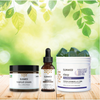Every Kava Strain To Know
Learn all about kava, its origins and benefits, and the different strains to consider when exploring this relaxing plant-based wellness supplement.

Interest in kava has grown steadily in recent years, especially among people looking for plant-based ways to support their emotional wellness and calm their minds at the end of the day. Once a lesser-known botanical from the South Pacific, kava is now found in wellness shops, cafes, and supplement aisles across the U.S.
Much of this interest is rooted in kava’s reputation for promoting a relaxed state of mind and helping people unwind without impairing cognition.* As a non-habit-forming botanical, kava appeals to wellness seekers who want something natural, rooted in tradition, and aligned with a more mindful lifestyle.
In this guide, we’ll explore what kava is, where it comes from, how it works, and how different strains may vary in their effects. Whether you’re just getting started or want to better understand the differences between popular varieties, this resource will help you feel more confident as you explore the world of kava.
What is kava?
Kava is a root harvested from the Piper methysticum plant, which grows throughout the South Pacific. People in Vanuatu, Fiji, Tonga, and other island nations have used kava in ceremonial and social settings for generations. The root is traditionally ground into a powder and prepared as a cold-water beverage.
What makes kava unique are its naturally occurring compounds called kavalactones. These active ingredients interact with systems in the body that are responsible for mood, relaxation, and brain activity.*
While researchers are still learning how kava works, many believe its effects are linked to how kavalactones interact with receptors in the central nervous system, particularly GABA-A receptors, which play a role in calming brain activity.*
Kava doesn’t contain THC, CBD, or any cannabinoids. It’s not derived from the hemp or cannabis plant, and isn’t considered psychoactive in the way that THC is. Instead, its effects are generally described as calming, grounding, or relaxing, depending on the strain and serving size.*
Today, kava is available in several forms — powdered root, tea, capsules, tinctures, and even ready-to-drink beverages. Some people prefer traditional kava preparation for its full-spectrum effect, while others opt for standardized extracts for convenience and consistency.
Where did kava originate?
Kava has a long cultural history in the South Pacific, where it continues to hold ceremonial, spiritual, and social importance. It’s believed to have originated in Vanuatu and spread through Fiji, Samoa, Tonga, and Hawaii over centuries through trade, migration, and cultivation.
In many Pacific Island communities, kava is more than just a beverage. It plays an important role in honoring ancestors and fostering communal connection. Traditional preparation involves grinding the dried root, mixing it with cool water, and straining it through a cloth to create a slightly muddy-looking drink.
The traditional experience of drinking kava is intentionally slow and intentional. It’s shared in communal bowls and consumed in a calm environment. That sense of ritual still informs how many people approach kava today — not as a quick fix, but as a tool for grounding, centering, and connecting, either alone or with others.
As interest in global wellness traditions continues to grow, kava has become more accessible to people outside the Pacific Islands, but its cultural roots remain central to understanding and respecting its use.
How are kava strains made?
Not all kava is the same. Different kava strains come from different cultivars (or genetic varieties) of the Piper methysticum plant. Just as soil, region, and climate can affect the taste and quality of grapes in wine, these same environmental factors influence the chemical makeup of each kava plant.
The differences between kava strains are largely determined by chemotype, a profile of the six major kavalactones found in the root. These kavalactones are numbered, and their order of dominance gives insight into the likely effects of the strain.
For example, a 245 chemotype may feel more mentally uplifting, while a 426 strain may be more sedating and body-focused.*
Kava is also categorized into two main types:
- Noble Kava: Considered the safest and most traditional type of kava. It’s rich in desirable kavalactones and produces balanced effects with low risk of side effects.* This is the variety most people seek out for wellness purposes.
- Tudei (Two-Day) Kava: A more potent but less predictable variety that can lead to longer-lasting effects and, for some, next-day grogginess.* Tudei kava is not recommended for regular use and is less commonly available in reputable wellness shops.
Strains can also be named after the region where they’re grown (like Vula Waka from Fiji) or given colloquial names based on their effects (like Melo Melo, known for its smooth, mellow feel). Understanding how these strains are classified helps people make more informed decisions based on their desired experience and wellness goals.
What does kava feel like?
The experience of kava can vary depending on the strain, the serving size, and the individual. People generally describe it as promoting a sense of calm, ease, and grounded focus.* Some may feel a gentle mental quieting, while others notice more physical relaxation, particularly in the neck, shoulders, and jaw.*
Unlike substances that may impair clarity or coordination, noble kava is often associated with a state of calm alertness — relaxed, but present.* That’s part of what sets it apart from alcohol or other social relaxants.
At lower serving sizes, some strains may feel mentally uplifting or even mildly euphoric.* These are often referred to as heady kavas and may be preferred during the day or in social settings. At higher serving sizes, what are considered heavy strains may promote physical relaxation, making them more suitable for evenings or times when someone wants to unwind fully.*
Some common sensations people report include:
- A warm or numbing sensation in the mouth (from traditional kava preparation)
- A gradual release of tension in the body*
- Mental quiet or less mental chatter*
- An overall peaceful or serene state*
It’s important to note that kava doesn’t affect everyone the same way. Body chemistry, previous experience, and how the kava is prepared all influence the outcome. Starting low and going slow is helpful for those trying it for the first time.
What are the benefits of kava?
For centuries, people have used kava for its naturally calming properties. Today, it’s gaining popularity among individuals looking to support emotional balance, ease feelings of tension, or simply unwind without turning to more habit-forming options.
Kava is not a one-size-fits-all botanical, but when used mindfully and responsibly, it may offer several wellness-supportive effects.*
Supports a calm mind and relaxed mood
One of the most common reasons people turn to kava is for its potential to promote relaxation and support emotional wellness.* This calming effect is linked to the way kavalactones, the primary active compounds in kava, interact with receptors in the brain involved in regulating mood and tension.*
Specifically, these compounds may influence the GABA system, which helps regulate feelings of calm and ease without producing a sedating or intoxicating effect when taken in moderation.*
Some people describe the effect as mentally quieting. Others find that kava helps them shift from a state of overthinking or restlessness into one that feels more composed and centered.* Because of this, kava is sometimes used as part of a wellness routine during times of increased stress, especially when paired with other self-care practices like breathwork or journaling.
May help support healthy sleep quality
Certain types of kava, especially heavier strains, are traditionally consumed in the evening and may support more restful sleep.*
While kava is not a sedative, its calming properties may help the body and mind wind down at the end of the day. By easing tension and promoting a sense of physical stillness, it may help create a more favorable environment for sleep, especially when paired with healthy sleep habits.* This can be particularly beneficial if you’re catching up on sleep debt.
It’s important to note that while some users report improvements in occasional sleep disturbances,* kava is not intended to treat sleep disorders. Individuals with ongoing sleep issues should speak with a healthcare professional.
Supports our natural stress responses
Kava may also play a role in helping the body respond to occasional stress.* Like other adaptogenic or calming botanicals, kava has been studied for its potential to buffer the impact of external stressors by supporting the body’s ability to stay balanced and grounded.*
This doesn’t mean kava blocks stress entirely, but some people find that it helps them navigate moments of pressure or overwhelm with greater clarity and ease.* This makes it a potential fit for those seeking to build more mindfulness into their daily routine.
Encourages social ease
Some strains of kava, especially those considered “heady,” are used to promote sociability and a relaxed mental state without the mental fog or inhibition associated with alcohol.* This has made kava bars increasingly popular in urban wellness circles. Some people turn to kava before social gatherings to feel more open and comfortable.*
That said, effects vary by strain and person. Some strains are better suited for daytime and conversation, while others are intended for deeper relaxation. Understanding the difference can help individuals choose the best option for their personal goals.
What does kava taste like?
If you're new to kava, the taste might catch you by surprise. Traditional kava has a very distinct flavor that’s often described as earthy, bitter, peppery, or slightly numbing. It's not sweet, floral, or smooth like herbal teas or flavored tinctures. For many kava drinkers, the flavor becomes part of the experience.
The root of the kava plant is typically ground, strained, and mixed with water to produce a cloudy, beige-colored beverage. It can have a gritty texture and a mouth-numbing effect, which is completely normal. This numbing sensation is caused by the kavalactones, the active compounds in kava that interact with the nervous system.*
Some people prefer to drink it quickly, almost like a wellness shot. Others incorporate kava into smoothies or mix it with flavored liquids to soften the taste. In recent years, kava bars have developed more palatable options using flavored syrups, juices, or plant-based creamers to create kava “mocktails” that are more approachable for new users.
If you're not ready for the traditional preparation, kava is also available in capsules, tinctures, and instant powders. These may not capture the full ceremonial aspect of kava drinking, but they can still deliver its calming benefits in a more convenient or familiar format.*
Is kava legal?
Kava is legal in many parts of the world, but its status can vary depending on the country and region. In the United States, kava is considered a dietary supplement and can be purchased over the counter in most states. It’s commonly sold in health food stores, specialty wellness shops, and online.
However, some countries have placed restrictions or bans on kava, especially where there have been past concerns about liver health.* For example, Germany and the United Kingdom previously prohibited kava sales, though some of these regulations have since been reevaluated in light of newer research and growing consumer interest.
The legal landscape for kava is evolving. In countries where it’s legal, regulatory agencies often require that kava products come from noble kava cultivars or strains that are traditionally used and generally recognized as safe for consumption when used appropriately.*
Tudei (or “two-day”) strains, which are not considered noble, are often discouraged or restricted in wellness formulations because they may be associated with unwanted side effects or prolonged grogginess.*
When sourcing kava, look for products that clearly identify the strain, chemotype, and source. Transparency, third-party testing, and noble classification are strong indicators of quality.
Before purchasing or traveling with kava, reviewing current laws in your area or destination is a good idea. Even if kava is legal in your home country, it may not be permitted in all regions, and importing it across certain borders may require specific documentation.
Are there any safety risks associated with using kava?
While many people use kava as part of their wellness routine, it’s important to approach it with mindfulness and informed caution. Like any botanical supplement, kava has potential risks, especially when used improperly or in high quantities.
Potential effects on liver health
The most commonly discussed concern around kava use is its potential impact on liver function.*
There have been case reports in the early 2000s of liver toxicity associated with certain kava products, though later research suggested that many of these cases involved poor-quality extracts, incorrect parts of the plant (such as stems or leaves, rather than the root), or use of non-noble strains.
Noble kava, when prepared traditionally and consumed in moderate amounts, has a much lower association with liver issues.*
Still, out of an abundance of caution, it’s best to avoid high servings and long-term daily use without guidance from a healthcare provider. This is especially true for those with a history of liver conditions or those who regularly use other liver-metabolized substances, such as alcohol or medications.
Potential interactions with other substances and medications
Kava may interact with certain medications, particularly those that act on the nervous system or liver.* These include sedatives, antidepressants, anti-anxiety medications, and some anticonvulsants. Mixing kava with alcohol is strongly discouraged. The liver processes both, so the sedative effects may be amplified.*
If you’re taking prescription medications, have a chronic health condition, or are pregnant or breastfeeding, it’s best to speak with a healthcare provider before adding kava to your wellness routine.
Consider your unique health needs
Kava is not appropriate for every person or every circumstance. It is not recommended for children, pregnant or breastfeeding individuals, or anyone with a history of liver issues or substance sensitivity. It’s also not advised to drive or operate heavy machinery after consuming kava, especially at higher serving sizes, until you know how your body responds.
As with any supplement, individual experiences with kava can vary. Factors such as body weight, metabolism, hydration, and even emotional state can influence how kava feels. For this reason, starting with a low serving size, especially when trying a new strain or form, is a responsible and supportive approach.
Quality is key
Many of the reported risks associated with kava come down to product quality. Using noble kava from reputable suppliers greatly reduces the likelihood of unwanted effects. Look for products that:
- Clearly indicate the strain and chemotype
- Use only the root (no stems or leaves)
- Are third-party tested for purity and potency
- Come from traditional growing regions, such as Vanuatu or Fiji
Choosing kava that meets these criteria can support both safety and effectiveness. Wellness is personal, and thoughtful sourcing helps ensure you’re aligning your wellness tools with your values.
What are some kava strains worth knowing about?
After understanding kava’s safety profile and knowing what to look for in high-quality products, the next factor to consider when starting your kava journey is what kind of strain to seek out.
There are dozens of known kava strains, each with a unique chemotype and unique effects. While individual experience can vary, understanding the core differences can help you choose the right strain for your wellness goals.
Here are some of the most widely used noble kava strains, organized by their general profile: heady, balanced, and heavy. Each one is derived from traditional Pacific Island cultivars and offers its own expression of kava’s relaxing potential.*
Heady Strains
Typically considered: Uplifting, mentally calming, social
These strains tend to produce more noticeable effects in the mind — clarity, lightness, and a sense of emotional ease.* They’re often preferred during the day or before social events. Heady strains may promote feelings of contentment and a calm, alert state without sedation.*
Vula Waka (Fiji)
Known for its smooth onset and slightly energizing effect, Vula Waka is popular among those seeking mental clarity and emotional balance.* It’s ideal for gentle unwinding without slowing down.
Borogu (Vanuatu)
A versatile, heady strain with a bright, clean effect that may help promote social ease and calm focus.* Often recommended for kava newcomers due to its gentle nature.
Pouni Ono (Tonga)
Uplifting and mildly euphoric, Pouni Ono is often associated with an easygoing, happy mood.* It’s a good option for relaxed conversation or creative tasks.
Balanced Strains
Typically considered: A mix of mental clarity and physical relaxation
These strains offer a combination of both mind and body relaxation, making them suitable for transitions — from day to night, work to rest. Many people find these strains ideal for evening use or winding down after a long day.
Loa Waka (Vanuatu)
Considered one of the most well-rounded strains, Loa Waka may promote both a calm mind and physical ease without heavy sedation.* It’s a staple for general relaxation.
Kelai (Vanuatu)
Known for its balanced nature, Kelai can bring a sense of inner stillness while keeping the body light and mobile.* Its subtle physical effects make it a favorite for evening rituals.
Nambawan (Vanuatu)
Translating to “number one,” this strain has a reputation for producing a centered, confident state of calm.* It may be mentally grounding with gentle body relaxation.*
Heavy Strains
Typically considered: Physically grounding, body-focused, best for evening use
Heavy strains are often more physically noticeable, producing a sense of stillness or even drowsiness in larger servings.* These are best used when deep relaxation or sleep support is the goal.*
Isa (Vanuatu)
A deeply grounding strain with heavier effects, Isa is typically reserved for nighttime use and is best suited for those seeking deep physical calm or to support poor sleep quality.*
Borongoru (Vanuatu)
Known for its strong body effects, Borongoru is not as heady as other strains but may promote a heavy, relaxed state, especially in the muscles and limbs.*
Melo Melo (Hawaii)
True to its name, this mellow strain is popular for promoting overall physical and mental ease.* It’s often described as smooth, warm, and soothing.*
How to choose the right kava strain for you
If you’re new to kava, the wide range of options can feel overwhelming, but it doesn’t have to be. Choosing a strain is less about finding the “best” one and more about identifying what type of experience you’re looking for.
Here are a few questions to ask yourself to guide your decision:
- What time of day do you plan to use it?
- Are you looking for mental clarity, body relaxation, or both?
- Do you have prior experience with kava or other calming botanicals?
If you want to stay emotionally grounded during a busy day or feel more open during a social event, look toward heady strains like Borogu or Pouni Ono. These are ideal for promoting a relaxed, clear-headed feeling without leaving you tired.*
Balanced strains such as Loa Waka or Nambawan offer a more even experience — a calm mind and relaxed body.* They’re great for easing out of work mode, supporting post-workout recovery, or winding down your evening.
Heavy strains are best used with intention — they promote deeper physical ease and may support better sleep quality when used in moderation and at the right time.* These aren’t for when you need to be alert or active. To support deeper rest, consider a heavier strain like Isa or Borongoru — in a lower serving to start.*
How to use kava
There are several ways to incorporate kava into your wellness routine, depending on your preferences and lifestyle. Understanding how it's traditionally used — and how modern formulations work — can help you find the best format for your goals.
Traditional preparation
The most authentic method involves kneading freshly ground kava root in cool water, then straining it through a cloth or mesh bag to remove coarse fibers. The result is a cloudy, peppery drink that's consumed in shells (small bowls) during ceremonies or social gatherings. This method preserves the full spectrum of kavalactones and offers a deeply grounding experience.*
However, traditional prep can be time-consuming and isn't for everyone, especially if you're just looking to relax after a long day.
Instant kava or micronized powder
Micronized kava is finely ground noble root that can be stirred directly into water or juice, no straining required. It offers a quicker preparation with a similar effect profile to traditional kava, though it may retain some grit and earthiness.*
Look for micronized powders made exclusively from noble root with no added fillers or non-root plant parts.
Kava capsules, tinctures, and gummies
Capsules and gummies are some of the most convenient ways to use kava. They're pre-measured and tasteless, making them ideal for travel or daytime use. Tinctures (liquid extracts) offer flexibility with serving size and can be taken directly or added to drinks.*
These formats are helpful for people who prefer precision and minimal prep, but remember that different extraction methods may affect how quickly you feel the effects.
Here at Sunmed, our vegan Kava Gummies are the perfect tasty treat to take on the go or enjoy before bed. Made with premium, third-party tested kava root extract harvested from the rich volcanic soil of the Pacific Islands, each gummy contains 100 mg of kavalactones and an all-natural mixed berry flavor for a delightful, consistent, and convenient way to unwind.
Kava beverages and mocktails
Ready-to-drink kava beverages are becoming more popular, especially in wellness cafes or kava bars. These can include carbonated drinks, herbal blends, or creamy mocktails that mask the flavor of traditional kava. They're often crafted with specific kava strains for desired effects — energizing, social, or sleep-promoting.*
No matter which strain and form of kava you choose, always source noble kava from reputable brands that provide third-party lab testing, clear chemotype information, and full transparency around sourcing. The quality and preparation method play a big role in your overall experience.
It’s always a good idea to start small and observe how each strain feels before increasing your serving size. When starting out, you may want to cut a gummy in half or slowly sip a single glass of your kava mocktail. It’s all about tuning into your body and creating a supportive routine around relaxation and mindfulness.
The bottom line
Real wellness starts with trust — in your body, in the science, and in the source. That’s the approach we bring to everything we create.
At Sunmed, we’re committed to helping people feel good naturally. That means producing high-quality, plant-derived wellness products that are clean, tested, and rooted in real science. Whether you’re exploring CBD, kava, or other functional botanicals, we want you to feel confident in what you’re using and supported in your wellness journey.
Every ingredient we use is carefully sourced, and every product is third-party tested to ensure safety and consistency. Our formulas are crafted with clarity and purpose, so you can choose the best path toward balance, calm, and long-term wellness.
Wherever you are in your journey — whether you're building a new nighttime routine or simply exploring more natural ways to care for yourself — we’re here to support you with education, integrity, and products you can trust.
*This statement has not been evaluated by the Food & Drug Administration. This product is not intended to diagnose, treat, cure, or prevent any disease.
Sources:
KAVA (Other Names: Ava, Intoxicating Pepper, Kawa Kawa, Kew, Sakau, Tonga, Yangona) | DEA
Kavalactones - an overview | ScienceDirect Topics
An Updated Review on the Psychoactive, Toxic and Anticancer Properties of Kava | PMC
Kava as a Clinical Nutrient: Promises and Challenges | PMC
Gamma-Aminobutyric Acid (GABA): What It Is, Function & Benefits | Cleveland Clinic
No level of alcohol consumption is safe for our health | World Health Organization













